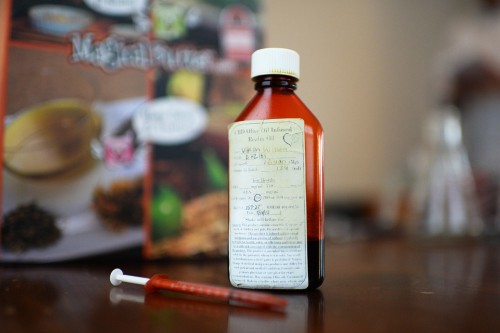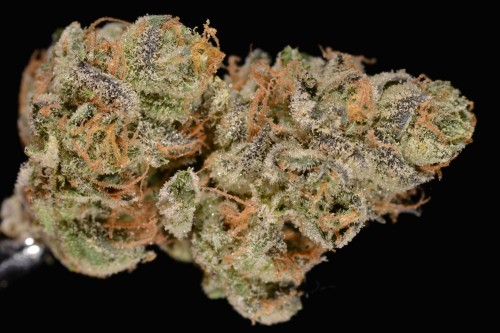On this page: C
C

Cannabidiol (CBD) — Gaining popularity as the primary therapeutic cannabinoid for a variety of diseases, specifically autism as well as epilepsy and other nerve-related conditions, cannabidiol is generally the second-most common cannabinoid found in cannabis, after THC. It is becoming highly sought after despite being nearly bred out of modern cannabis in the hunt for the highest THC strains; many breeders now pride themselves on their CBD-to-THC ratios instead. Traditionally, hemp varieties have varying amounts of CBD but almost no THC.
• “This high CBD strain has really helped with my seizures.”
Health matters: Can hemp heal? Questions of science vs. semantics
Cannabinoid (see also: CBC, CBCV, CBD, CBDA, CBDV, CBG, CBGV, CBL, CBN, CBV, THC, THCA, THCV) — The chemical compounds found within the cannabis plant, cannabinoids come in both psychoactive and non-psychoactive varieties, but all of them act upon the human body’s built-in cannabinoid receptors. Cannabinoids can be absorbed via inhalation or ingestion (both of which go into the bloodstream) as well as transdermally, which acts directly upon cannabinoid receptors (primarily of the CB2 variety) which lie throughout the skin and nervous system. In the acid form (THCA, CBDA, etc.), the cannabinoids are not active, but still carry various medicinal properties when consumed, as seen in the case of juicing raw cannabis leaves. In order to decarboxylate and therefore activate the acidic form cannabinoids, heat is required — when you smoke cannabis, this process is what is allowing the plant to have a chemical effect; when you make a batch of cannabutter, the cannabinoids are getting decarboxylated and becoming orally active.
• “CBD seems to be the most effective cannabinoid in relieving the symptoms of my MS.”
Carb cap — A specially-crafted implement (normally made of titanium, but sometimes quartz or ceramic) which fits over a domeless nail. The purpose of a carb cap is to allow a full hit while keeping the nail at a lower temperature, which makes for a more flavorful dab. Terpenes, the flavor compounds in cannabis, are quickly degraded and changed by heat, so using a carb cap to “stoke” the oil allows the hit to still vaporize, but retains the maximum amount of flavor.
• “Quick, give me the carb cap, I’m practically hemorrhaging terps over here!”
Cashed — When a bowl burns away to nothing but ash.
• “That bowl is cashed, pack up another one!”
Cheeba — Slang term for cannabis. Famously part of Colorado’s most ubiquitous edible companies, Cheeba Chews.
• “Pass the cheeba.” “I shouldn’t have eaten that whole Deca Dose Cheeba Chew.”
Cherried — When a bowl stays lit and no lighter is needed. This usually happens late in the bowl, but if your weed is super dry, it can happen from the start.
• “Nah, keep the lighter… it’s cherried.”
Clone — A clipping from a cannabis plant, which can then be rooted and grown. Like many plants, cannabis can be asexually propagated via cloning, which creates an exact genetic copy of the “mother plant.” Most cannabis strains are really nothing more than a chosen close which has been passed around.
• “I forgot to take a clone off of that Skywalker OG before I flowered it, and now I’m kicking myself.”
Closed-loop extraction — Chemical extraction (whether using a hydrocarbon solvent or CO2) using a closed system, which means that the machine recycles the solvent rather than dispersing it in the air. Most commonly this is referring to a butane or propane extraction, but technically CO2 extraction machines are also closed-loop. A closed-loop system is much safer than traditional “open blasting” methods, and as such are now required for all legal concentrate production in Colorado.
• “We use a closed-loop extractor because we aren’t idiots and don’t want to blow our facility up.”
Map: Colorado recreational marijuana shops and medical dispensaries
CO2 extraction — When high pressure is applied to CO2, it becomes a liquid that is capable of working as a solvent, stripping away cannabinoids and essential oils from plant material. This process is called supercritical extraction and is the most common method of making hash oil using CO2 instead of a hydrocarbon solvent such as butane. CO2 extractions can take many of the same textures as BHO, but generally they tend to be more oily and less viscous.
• “We just spent $100,000 on a new supercritical CO2 extraction machine and we are starting an edibles company.”
Concentrate — The word “concentrate” in the cannabis world refers to any product which refines flowers into something more clean and potent. This umbrella term includes any type of hash (water hash, pressed hash), dry sieve (kief), as well as any hash oils (BHO, CO2 oil, shatter, wax, etc.) and indicates that these products are a concentrated form of cannabis, carrying a much higher potency.
• “I don’t really smoke flowers anymore. I’m more of a concentrate smoker these days.”
Cone — The European style of joint, which is slightly conical rather than straight, getting wider towards the end. Most cones also include a rolled paper “crutch”, which works to keep the weed from falling out the small end, but also helps aerate the joint so the resin doesn’t cake the end shut. In Amsterdam and many other places around Europe, smoking joints with pure cannabis is rare — most locals will be found with a mix of cannabis or hash and tobacco.
• “I hate when you roll those pinner joints… let me show you how to roll a proper cone instead.”
Cotton mouth — When you smoke weed and your mouth gets dry. Often, cotton mouth is accompanied by its cousin, known as “the munchies.”
• “Ugh, that Romulan gave me wicked cotton mouth, we have to go get something to drink.”

Crystals — The common layman’s term for the cannabis plant’s trichomes. These tiny structures contain the vast majority of the plant’s cannabinoids, and are what is removed to create concentrates such as hash, hash oil, and kief.
• “That bud is covered in crystals… er, I mean trichomes.”
Cure — The curing process is a very important step in a well-grown cannabis plant’s life cycle. After being harvested, trimmed, and sufficiently dried, the plant’s flowers are then put into airtight containers which slows the drying, allowing for a more measured and gradual process, which helps to maximize the flavor and smoke quality. Similar to what you would see with cigars or even wine, the drying and aging process develops deeper flavors and mellows the smoke. Uncured or improperly cured flowers often taste and smell like hay, burn badly, and are harsh on the throat.
• “Wow, you can really taste the three-month cure on this Sour D… it’s like I ate a flaming skunk stuffed with lemons and tires.”
More terminology
A-B | C | D | E-F | G-H | I-J-K | L-M-N | O-P | Q-R | S | T-V | W-Z/Numbers
